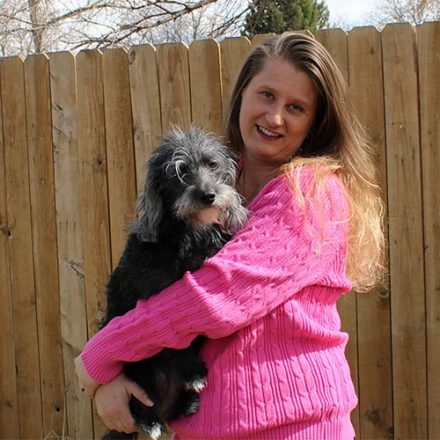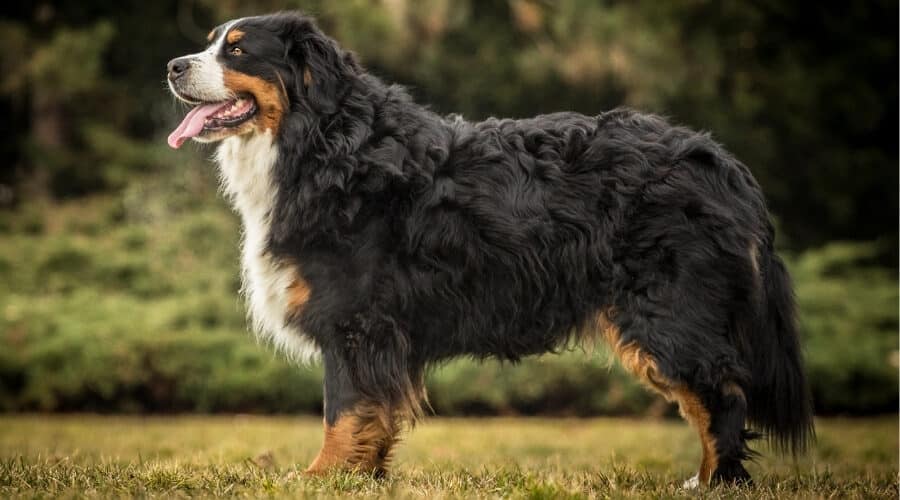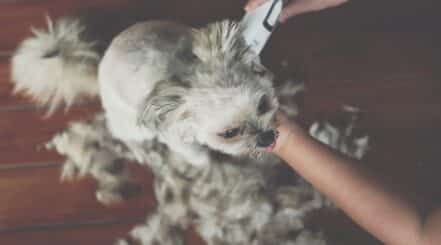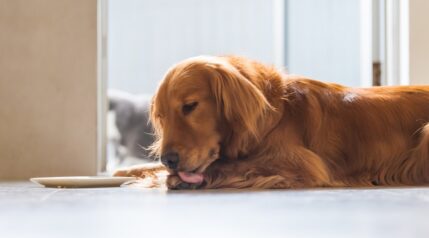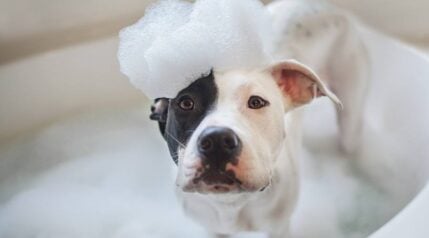Do you think the Bernese Mountain Dog could make an excellent canine companion, but you need to know how much they shed before you welcome one into your home? With their stunning good looks and fluffy dog fur, Bernese Mountain Dogs (also known as Berners) have surged in popularity over the last decade. Due to their even-keeled temperament, they’ve become quite common as family pets. But how do you manage Bernese Mountain Dog shedding and all that fur?
It’s probably obvious that Bernese Mountain Dogs shed. So, you’ve either landed here looking for how much shedding you can expect before you adopt one, or you own one already and can’t seem to figure out why they might be shedding more than normal.
You may wonder, “Are Bernese Mountain Dogs high maintenance?” The answer is yes, they sure are due, in large part, to the high amount of shedding. Berners need regular grooming and maintenance, and a lot of that centers around their heavy coats. Let’s get into all the details about the Bernese Mountain Dog’s shedding and what you need to know to manage it.
Berner Coat Length & Density
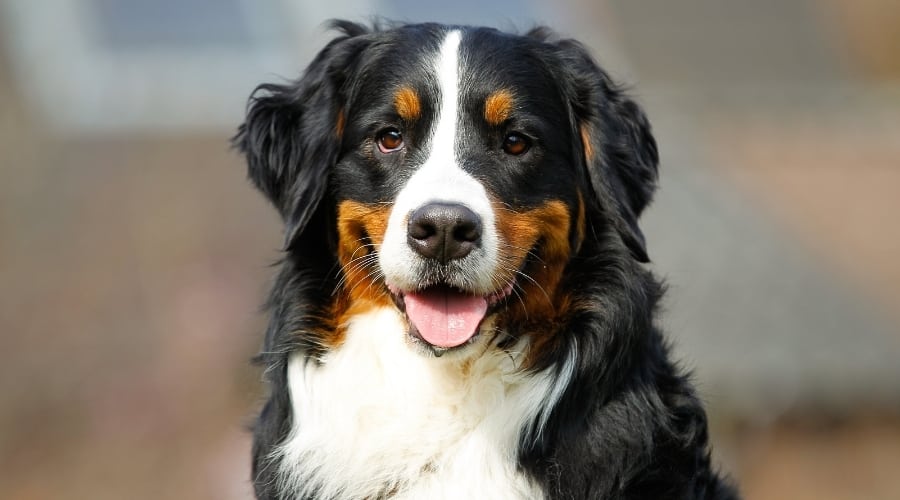
The Bernese Mountain Dog breed is famous for its long, beautiful, thick coat. The Berner has a double coat: a top coat to help them resist the elements, followed by an undercoat to help keep them warmer or cooler, depending on the season. Their undercoat is thicker in the winter and lighter during the summer.
Owning a Berner means that you can expect a fair bit of fur to clean up after, especially during shedding season. Their coats are one of their most distinguishing factors when it comes to their appearance. Because of their long coats and Swiss heritage, people often mistake them for Saint Bernards.
Coat Colors
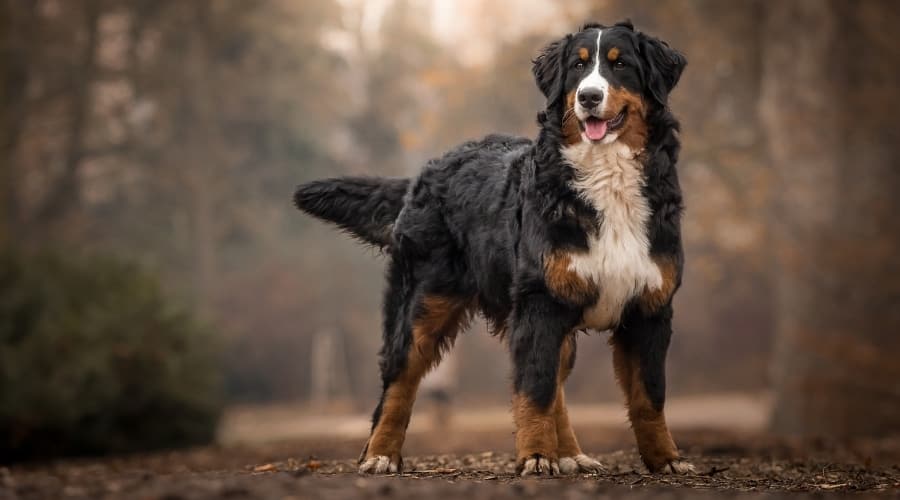
The Bernese has a very limited color combination to be considered breed standard. Many have mostly black coats mixed with white and copper. Their color combination is also shared with other mountain dog breeds from Switzerland who share similar origins. Because their coats generally have more black fur than other colors, they tend to blend in better for owners who have darker-colored flooring or furniture. Those who have lighter-colored furniture must stay on top of their grooming routine a little bit more fervently.
Bernese Mountain Dog Shedding Frequency
The Berner is a year-round shedder, but shedding intensity grows during the summer and winter. Because they have longer fur, the fur they leave behind is more noticeable than that of a German Shepherd, or other double-coated dog breeds. This is the time of year when their undercoats start to shed to make way for a thicker or thinner undercoat, depending on the temperature outdoors.
During their “blown-coat” season, you need to brush your Bernese regularly. In fact, during the early summer, you’ll likely want to resort to daily brushing just to keep the fur down. Brushing is usually the first line of defense to keeping your home somewhat fur-free during shedding season.
Other Reasons For Shedding

If you already own a Berner, there may be other reasons they are shedding more than normal. Outside of “shedding season,” there are several other things that can impact the frequency of how often their fur is falling out. If your Bernese is shedding more than normal, here are a few things to look out for.
- Stress & Anxiety: The Bernese is naturally a more anxious breed. They can suffer from separation anxiety, and excessive shedding is one of many common symptoms of an anxious or stressed-out dog. Any routine changes can stress them out, and this includes not spending enough time with family or welcoming a new dog or baby into your home.
- Change in Diet: Changes in diet can impact how often your Bernese sheds. Some dogs may need to switch to a limited-ingredient food line. It’s not uncommon for this breed to suffer from grain allergies, so consider a grain-free formula if you notice more shedding than normal.
- Skin Conditions: Mites, fleas, and other bugs can cause skin conditions that cause your pup to shed more frequently than normal. It’s also possible your dog has a skin allergy to a new dog treat or dog shampoo that you’ve introduced them to.
- Health Conditions: While less common, serious health concerns such as alopecia, mange, allergies, and more can cause additional fur loss. If your dog’s behavior has changed in addition to seeing more fur around your home, consult your veterinarian.
Shedding Management & Tips

An effective DIY grooming routine is necessary for all heavy-shedding breeds. If you can’t manage to brush daily during shedding season, along with monthly bathing, consider a Bernedoodle, which mixes a Berner with a Poodle. These pups often carry the same coloring and are known for shedding less than their Bernese parent.
If you are ready to deal with your Berner’s shedding habits, there are some steps to take. These will help keep your dog’s coat healthy, prevent matting, and help manage the amount of hair in your home. Regular grooming is a necessity with this breed.
Brushing
Regular brushing should be done about three times per week during normal shedding seasons. This should be enough to keep the fur away from your home and off your furniture. I recommend using a longer pin brush. Using a bristle brush will not give you the depth you need to keep the coat flowing and tangle-free.
A longer pin brush will help you get into their undercoat during brushing sessions, which is where you can find a lot of dead dog fur. A slicker brush may also be helpful, especially when removing matting or tangles. During the winter and the summer shedding seasons, consider daily brushing. Daily brushing for this breed. At a minimum, you should consider every other day.
I also recommend picking up a deshedding tool. These tools can be used more sparingly. They help get deeper into the fur and pull out loose fur that a brush can’t grab. They are usually fairly budget-friendly, and there are a few very popular models that will do the job with ease.
Bathing

You shouldn’t bathe your Berner more than once per month. Occasionally, your pup may need a bath after a romp in some mud, grass, or leaves. Doing it more than once a month won’t be detrimental to their coat health as long as it’s not a routine occurrence.
Regularly bathing your dog more than once per month will dry out their skin and can deplete the natural oils that their coats need to stay healthy. Because the Berner’s coat is long and dense, they are likely to develop an odor. Regular bathing will help keep them smelling fresh.
Shampoo
You won’t need an anti-shed formula unless you are brushing regularly and don’t see the results you need. Some anti-shed formulas contain harsh chemicals, while others do not. I recommend going this route only if you don’t see less fur around your home after a very regimented brushing routine. Use a natural or oatmeal dog shampoo for regular bathing to keep your Berner’s coat healthy. Learn more about some of the top oatmeal shampoos for dogs here.
Diet
Most dog owners completely ignore diet when it comes to coat health. But diet is one of the “lower hanging fruits” you can go after as a pet parent. Ensuring the dog food your pup eats is high in omega fatty acids will go a long way in helping ensure their coats stay healthy and shiny. It can take up to a month to start seeing the effects of premium dog food on your pup’s coat health. I’d recommend looking at grain-free foods like some of the premium formulas by Taste of the Wild to help keep your Berner’s coat healthy. You can also consider adding fresh dog food to your pup’s bowl. Options like The Farmer’s Dog, Ollie, and Spot & Tango deliver ready-made, top-notch, fresh meals right to your door.
Supplements
If your pup hasn’t responded to a change in diet, supplements are always an option. Usually, a good omega fatty acid supplement is all you need for skin and coat health. Many brands create skin and coat health chewable dog supplements, and I’d recommend using these for ease of use. It’s best to discuss any supplements with your vet first, especially if your dog has any medical conditions or is on a special diet.
Frequently Asked Questions
Do you still have some unanswered questions when it comes to fur management? Below are some of the most commonly asked questions when it comes to Berner shedding habits. If I missed yours, let me know in the comments.
Are Bernese Mountain Dogs hypoallergenic?
No, these pups are not hypoallergenic. They have a thick double coat, lots of dander, and shed heavily. If you have dog allergies, this breed may not be the best pick for you.
Which tool is best to help keep my Berner’s fur out of my house?
A wire brush will be your best friend. During shedding season, consider looking at a deshedding tool to help keep their blown coat outdoors and not on your clothing.
Do Bernese Mountain Dogs shed all year?
Yes, this breed sheds all year, and there’s really no way to avoid it. Fortunately, it’s easily managed with care and regular grooming Also, as mentioned, Berners shed more in the summer and winter, so expect to spend more time grooming at that time of year.
Why is my Berner shedding more than normal?
Stress and anxiety are two of the top non-seasonal shedding triggers for just about any breed. So, if you notice more dog fur around your house, make sure there’s been no recent routine change or added stress. If you have concerns or your dog is acting differently, seek the advice of your veterinarian.
When do Bernese Mountain Dogs shed their coats?
Berners shed season year-round, with the heaviest months coming in early summer and early winter. Your Berner will either grow thicker hair to keep themselves warm underneath or shed some of it to stay cool.
Looking For A Lower Shedding Breed?
If you love a fuzzy dog but are not sure the Berner is right for you, consider a few other lower-shedding breeds. The hypoallergenic Poodle is always a top pick, as is the Bichon Frise and the adorable French Bulldog. Keep in mind that even low-shedding breeds shed and need regular care and coat maintenance.
Why Trust Us?
Danielle has shared a special bond with dogs since childhood. She has over 30 years of experience with dogs of all sizes and dogs with special needs. Danielle is a dedicated professional researcher and pet product reviewer. She spends countless hours researching the latest pet care, health, food, and training developments to help owners learn what’s behind the label. Her two dogs, Daisy and Falkor, serve as in-house assistants and product testers. Danielle works with a professional and experienced team to bring the best, most accurate, and most up-to-date information to our readers.
